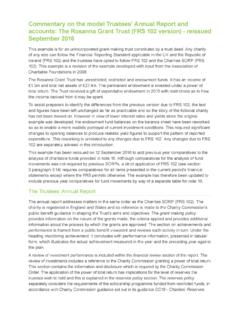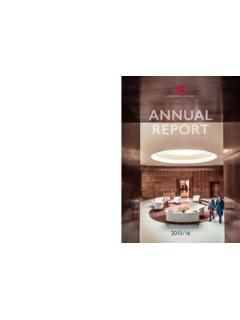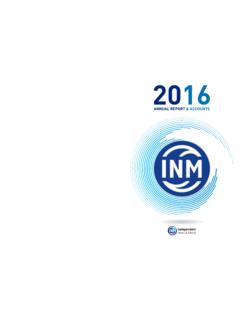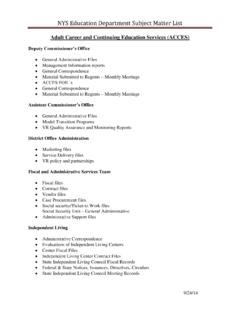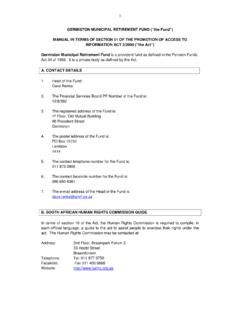Transcription of SEP Retirement Plans for Small Businesses - irs.gov
1 SEP Retirement Plans for Small Businesses is a joint project of the Department of Labor s Employee Benefits Security Administration (DOL/EBSA) and the Internal Revenue Service. To view this and other EBSA publications, visit the agency s website at: order publications or to request assistance from a benefits advisor, contact EBSA electronically at: call toll free: publication will be made available in alternative format to persons with disabilities upon request: Voice phone: 202-693-8664 TDD: 202-501-3911 This publication constitutes a Small entity compliance guide for purposes of the Small Business Regulatory Enforcement Fairness Act of 1996. It does not constitute legal, accounting, or other professional for an easy and low-cost Retirement plan?
2 Why not consider a SEP?Simplified Employee Pension (SEP) Plans can provide a significant source of income at Retirement by allowing employers to set aside money in Retirement accounts for them-selves and their employees. Under a SEP, an employer contributes directly to tradition-al individual Retirement accounts (SEP-IRAs) for all employees (including themselves). A SEP does not have the start-up and operating costs of a conventional Retirement plan and allows for a contribution of up to 25 percent of each employee s of a SEPq Contributions to a SEP are tax deductible and your business pays no taxes on the earnings on the investments. q You are not locked into making contribu-tions every year. In fact, you decide each year whether, and how much, to contrib-ute to your employees SEP-IRAs.
3 Q Generally, you do not have to file any documents with the Sole proprietors, partnerships, and corpo-rations, including S corporations, can set up SEPs. q You may be eligible for a tax credit of up to $500 per year for each of the first 3 years for the cost of starting the Administrative costs are low. As you read this booklet, here are some defi-nitions you will find helpful: Employee An employee is not only some-one who works for you, but also includes you if you receive compensation from the busi-ness. In other words, you can contribute to a SEP-IRA on your own behalf. The term also includes employees of certain other business-es you and/or your family own and certain leased Employee An eligible employee is an employee who: 1.
4 Is at least age 21, and 2. Has performed service for you in at least 3 of the last 5 years. All eligible employees must participate in the plan, including part-time employees, seasonal employees, and employees who die or termi-nate employment during the year. Your SEP may also cover the following employees, but there is no requirement to cover them: q Employees covered by a collective bargain-ing agreement that does not provide for participation in the plan, if Retirement bene-fits were the subject of good faith bargain-ing;q Nonresident alien employees who did not earn income from you; orq Employees who received less than $600 in compensation during the year (subject to cost-of-living adjustments). Compensation The term generally includes the pay an employee received from you for a year s work.
5 As the owner/employee, your compensation is the pay you received from the company. You must follow the definition of compensation included in your plan document. - 1 -ESTABLISHING THE PLAN There are just a few simple steps to establish a 1: Contact a Retirement plan profes-sional or a representative of a financial insti-tution that offers Retirement Plans and choose the IRS model SEP, Form 5305-SEP, Simplified Employee Pension Individual Retirement Accounts Contribution Agreement, or another plan doc-ument offered by the financial institution. Regardless of the SEP document you choose, when filled in, it will include the name of the employer, the requirements for employee participation, the signature of a responsible official, and a written allocation formula for the employer s SEP may be established as late as the due date (including extensions) of the company s income tax return for the year you want to establish the plan.
6 For example, if your busi-ness s fiscal year (a corporate entity) ends on December 31 and you filed for the automatic 6-month extension, the company s tax return for the year ending December 31, 2015, would be due on September 15, 2016, allow-ing you to make the initial SEP contribution no later than September 15, 2016. Choosing a financial institution to maintain your SEP is one of the most important decisions you will make, since that entity becomes a trustee to the plan. Trustees work with employers and agree to:q Receive and invest contributions, andq Provide each participant with a notice of employer contributions made each year and the value of his/her SEP-IRA at the end of the of SEP-IRAs are generally banks, mutu-al funds, insurance companies that issue annu-ity contracts, and certain other financial institu-tions that have been approved by the 2: Complete and sign Form 5305-SEP (or other plan document if not using the IRS model form).
7 When it is completed and signed, this form becomes the plan s basic legal document, describing your employees rights and benefits. Do not send it to the IRS; instead, use it as a reference since it sets out the plan terms (for example, eligible employ-ees, compensation, and employer contribu-tions).Step 3: Give your employees a copy of the Form 5305-SEP (or other plan docu-ment if not using the IRS model form) and its instructions, along with certain informa-tion about SEP-IRAs (described in Employee Communications below). The model SEP is not considered adopted until each employee is provided with a written statement explain-ing that:1. A SEP-IRA may provide different rates of return and contain different terms than other IRAs the employee may have;2.
8 The administrator of the SEP will provide a copy of any amendment within 30 days of the effective date, along with a written explanation of its effects; and3. Participating employees will receive a writ-ten report of employer contributions made to their SEP-IRAs by January 31 of the fol-lowing THE PLAN Once in place, a SEP is simple to operate. Your trustee will take care of depositing the contributions, investments, annual statements, and any required filings with the IRS. You will need to ensure that your plan is kept current with the to SEP-IRAsYour obligation is to forward contributionsto your financial institution/trustee for thoseemployees who participate as described in yourplan document. You will want to keep yourfinancial institution aware of any changes in thestatus of those employees in the 2 -As you hire new employees, for instance, you will include them in the SEP if they satisfy the eligibility criteria described in the plan.
9 Your contributions to each employee s SEP-IRA for a year cannot exceed the lesser of 25 percent of the employee s compensation for the year or a dollar amount that is subject to cost-of-living adjustments. The dollar amount for 2015 and for 2016 is $53,000. These lim-its apply to your total contributions to this plan and any other defined contribution Plans (other SEP, 401(k), 403(b), profit sharing, or money purchase plan) you do not have to contribute every year. When you contribute, you must contrib-ute to the SEP-IRAs of all participants who performed work for your business during the year for which the contributions are made, even employees who die or termi-nate employment before the contributions are made.
10 Contributions for all participants generally must be uniform for example, the same percentage of salary reduction contributions can-not be made under a are special rules if you are a self-em-ployed individual. For more information on the deduction limitations for self-employed individuals, see IRS Publication 560, Retirement Plans for Small Business (SEP, SIMPLE, and Qualified Plans ).How Does a SEP Work?Quincy Company decides to establish a SEP for its employees. Quincy has chosen a SEP because its industry is cyclical in nature, with good times and down times. In good years, Quincy can make larger contributions for its employees, and in down times it can reduce the amount. Quincy knows that under a SEP, the contribution rate (whether large or Small ) must be uniform for all employees.










